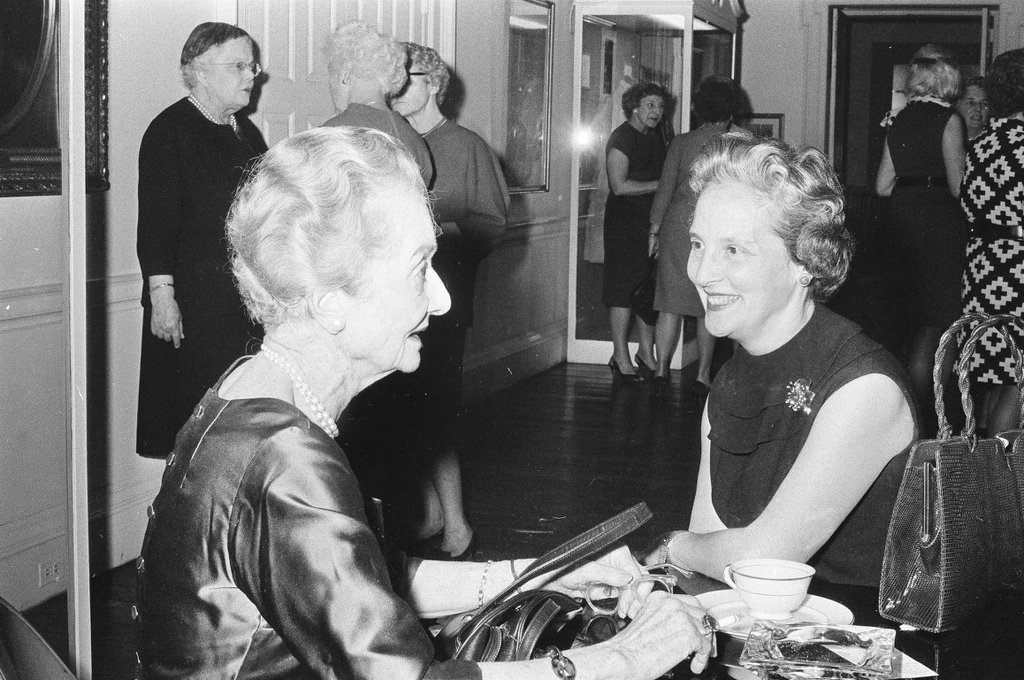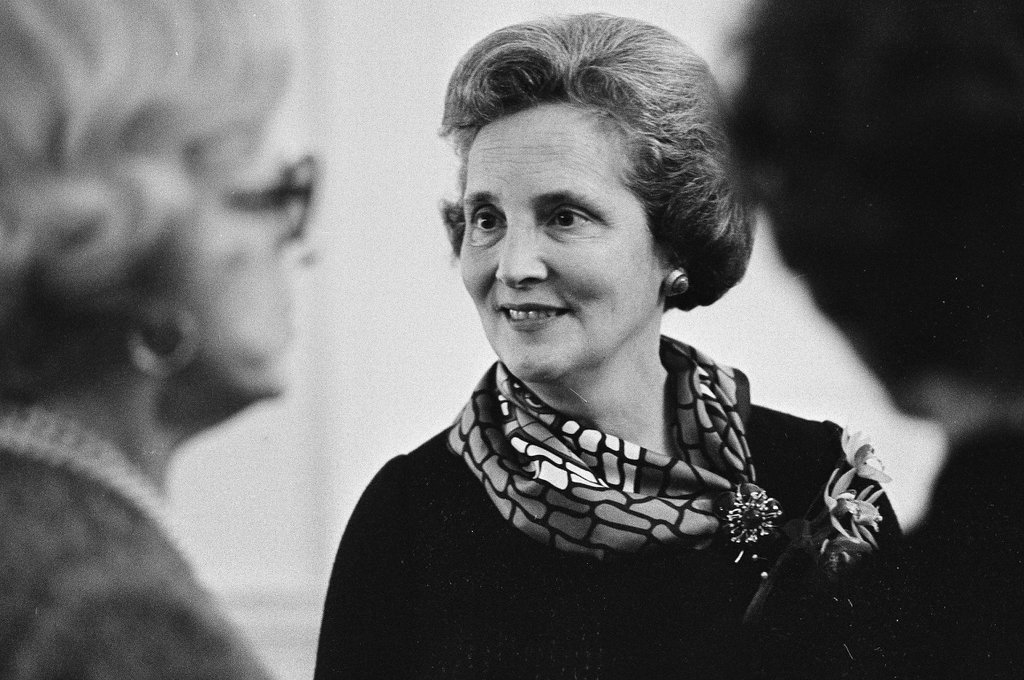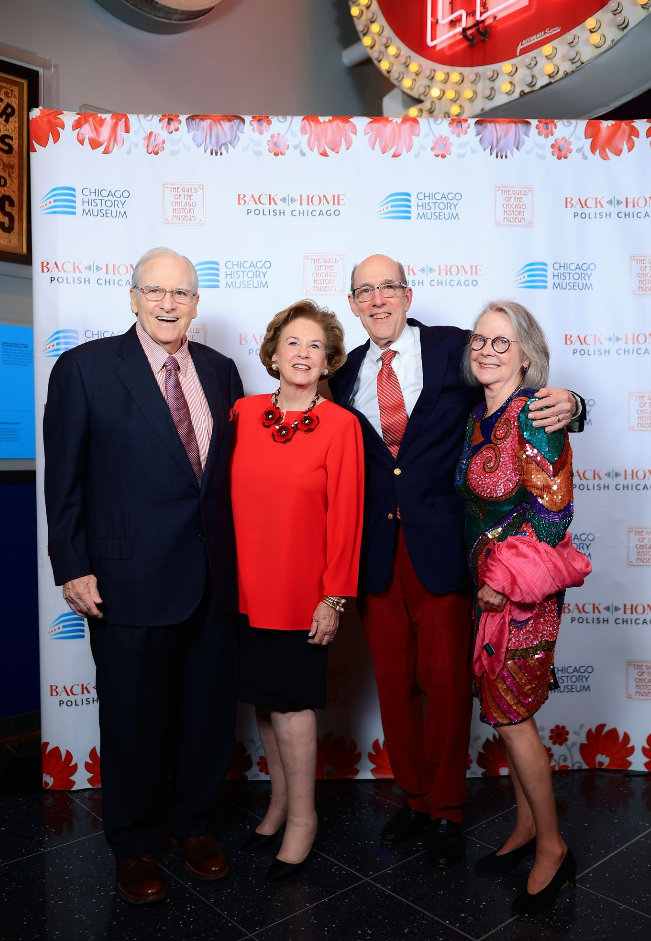
By Judy Carmack Bross
“For 75 years the women who have been members of the Guild of the Chicago History Museum have shown their commitment by being advocates for the Museum and for Chicago history in the larger community, raising millions of dollars to fund our exhibitions, offering lifelong learning and programs about this great city we live in, and essentially always responding when the Museum needs help.”—Michael Anderson, Vice President for External Engagement and Development at the Chicago History Museum.

Guild programs have always fostered great interest in Chicago history
Having just completed a campaign to restore the iconic L car No. 1 which took visitors to the 1893 World’s Fair, welcomed more new members than ever in recent years, built new networks with non-profits sharing a similar championing of Chicago history, and offering programs that focus in part on women’s leadership, the Guild of the Chicago History Museum has much to celebrate in its 75th anniversary year.

Chicago History Museum Vice President of External Engagement and Development Michael Anderson, Guild President Jill Kirk, and Museum President Donald Lassere
Guild President Jill Kirk told us:
“We are looking towards a year of greatest engagement with the Museum, with more of the popup events that have been so popular in showcasing the passion, talent and knowledge of our members and our connectedness with other women’s groups in our City.”
Kirk previously served as Development Director of the Evanston History Center in the Charles Gates Dawes House in Evanston and now is on staff at the Black Point Estate and Gardens in Lake Geneva and sums up the feeling of Guild members when she says: “I just love history!” She adds: “We can learn so much at the Museum. Guild members often gather at the L car and then have lunch together in the Museum café to talk about Chicago books or the latest exhibits. The World’s Fair exhibitions embody what we are all about, and whenever I need a moment I just sit in the L car. It is great to listen to all the school kids as they explore the Crossroads Exhibit with such excitement.”
Michael Anderson points out that Guild members are like extensions of the staff, sharing Chicago stories in the larger community. “Everyone loves Chicago stories and they are so multi-faceted, the good, the bad and the ugly. History isn’t all rosy– there is of course bootlegging, corruption and the like, but it is a tapestry that our Guild well understands,” he said. “Members serve as advocates for Chicago history. We have over 30 million objects in our collection and we are so lucky at the History Museum and other institutions in town to have such a vast repository and people who love what’s unique about our City, such as the Guild.”
On September 24, museum curator Olivia Mahoney will speak and lead a tour of “Designing for Change,” a new exhibit on social movements and protest art of the 1960s and 70s. On September 30 the public is invited to a program developed through a partnership with the Junior League of Chicago, one of several like-minded groups with whom the Guild networks. “Women Shaping Democracy” presented by Emily Amick, author of Democracy in Retrograde, will relate how women can build community through civic action.
A luncheon and presentation on November 7 of the upcoming costume exhibition “Dressed for History” highlights that the Costume Council grew out of the Guild, and on January 26, Jill Wine-Banks, attorney, MSNBC Legal Analyst and former Watergate Prosecutor, will be the guest speaker.
Not to be forgotten is the Guild’s salute to families—the December 4th Great Lakes Dredge and Philharmonic Society concert which has become a tradition.

Connie Barkley, left, and Erica Meyer, far right, co-chairs of a Guild benefit entitled “A Night of Intrigue” with former CIA operative Valerie Plame Wilson and Mary Ann Ahern.
The Guild funds many major CHM projects, and since the 1970s, has raised more than $2.5 million for the Museum. From 1967 to 1975, it contributed over $50,000 to build a new wing. In a modernization project launched in 1985, The Guild raised over $1 million, making it the largest support group donor to the campaign. To honor this achievement, the original 1932 Georgian-style building was dedicated to The Guild.

Connie Barkley with the late and beloved Susie Stein

Guild Member Karen Zupko at the Chicago History Museum
As a leader among women’s boards, the Guild hosted a historic luncheon in 2012 for 18 women’s boards serving Chicago’s cultural community. A plaque commemorating this historic event is on permanent display in The Guild Room.
Guild funds have also supported the Digital Photography Studio and the Museum’s Card Catalogue Conversion Project as well as the preservation of the Kukla, Fran, and Ollie puppets and preservation of a doll saved during the Chicago fire.

Mrs. Philip K. Wrigley (left) and Mrs. Homer P. Horgrane, Jr. (second from right) having tea at the Annual Meeting of the Chicago Historical Society and Guild, October 27, 1971

Women drinking tea at a meeting of the Guild of the Chicago Historical Society, Chicago, Illinois, 1969
In 1948, the Museum’s trustees voted to establish a woman’s auxiliary and the Guild archives are a fascinating read. We share a a description of its beginnings, and in a future article will highlight more about its early members, prominent and fascinating women who helped build Chicago.
“Seated in the beautiful paneled drawing room of Mrs. Joseph M. Cudahy’s apartment at 1500 North Lake Shore Drive on the afternoon of December 10, 1948, were some of Chicago’s most social and civic minded women. They were there for the purpose of forming a women’s group to support the Chicago Historical Society. Feminine membership in the 91-year-old Society had long been a guiding force in the creation of the museum’s invaluable collection of treasures, but it was just in the most recent years that formation of a woman’s group had been pushed. Mrs. Cudahy’s late husband had been President of the Society and his widow was persuaded to become a trustee, and was a prime mover in organizing the Guild. Though she refused to become its chairman, she continued her personal and financial support. So that late December afternoon in her apartment, Mrs. James Hopkins, whose late husband was for years the vice president of the society was chosen Guild Chairman, Mrs. Howard Linn, whose brother William McCormick Blair was the Society’s President was named vice chair and Mrs. Richard L Stearns became the secretary-treasurer.”
The scribe added that Mrs. Cudahy’s Pekinese Golda, Belle of Fairway was also present and wasn’t pleased with the lengthy meeting.

Women drinking tea at a meeting of the Guild of the Chicago Historical Society, Chicago, Illinois. Date unknown
 Members of the Guild of the Chicago Historical Society (Chicago History Museum) hold their annual meeting, Chicago, Illinois. Jan 29 1969
Members of the Guild of the Chicago Historical Society (Chicago History Museum) hold their annual meeting, Chicago, Illinois. Jan 29 1969
Later, Mary Frances Rymer, longtime curator of prints and photographs at the Society, recalled Mrs. Cudahy as one of the superwomen who ran the Guild, saying: “She is literally interested in everything about the society, and sparkled when she asked this newcomer don’t you just love all this funny stuff?”
Rymer continued for the archives: “She would come in in the afternoon with her luncheon companion, either a visiting niece or her best friend Mrs. Charles Garfield King, and they would drop down in our first floor offices for that one Turkish cigarette she allowed herself each day. The pervasive odor of the Turkish cigarette would waft through the building’s ventilating ducts and the staff would know that their favorite trustee and benefactor would be visiting. Our longtime director Mr. Angle thought it a wry fact that Mrs. Cudahy avoided eating meat because the family was prominent in the meat packing business.”
The archives also relates: “Further testimony to Mrs. Cudahy, who set the tone for the Guild, is in the memorial to her by the Guild given to her brother Sterling Morton five years later. She was called the guiding spirit who had great understanding in the value of historic research.”
Notably, something still so important today.

Polly Hutchins became President of the Guild in 1972
Following the meeting at the Cudahy apartment, the Chicago Historical Society’s Director Paul M. Angle, outlined the Guild’s purpose: “To further public interest in the Chicago Historical Society and to encourage and promote the general activities of the Society; to create a friendly atmosphere for special events; to assist in entertaining distinguished visitors at the Museum or in private houses; to use members’ influence in acquiring outstanding exhibits; and to arrange meetings for exhibits.”
Louise Dewey Smith, the Guild’s Second Chairman, noted in the archives: “Guild members were low key, that they gave credit to others and they were bright and imaginative in the days when people weren’t. They knew how to make things work.”
And from Rymer: “Many of the early members of the Guild, in addition to their smarts, had developed a sense of history, and this is what the Society is all about. They placed their fine Chicago pieces their portraits, clothes and fine furniture at CHS for the use of future historians and scholars—and for exhibits of Chicago history.”
The sense of Chicago history and the feeling that no one does it better than the Chicago History Museum is a thread throughout the Guild’s history.

Two Guild Presidents: Lawrie Weed, past president, and Jill Kirk, current, with their husbands Ed Weed and John Darrow
Gary T. Johnson, Museum President Emeritus, said: “The Guild always has been the Museum’s best friend.”
For further information about the Guild of the Chicago History Museum visit: chicagohistory.org/join-and-give/the-guild/.







